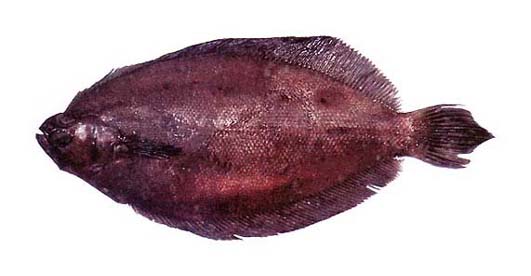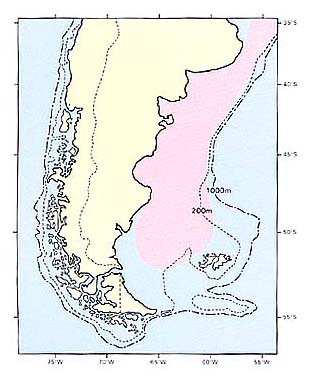ダルマガレイ科
- HOME
- デジタル図鑑
- パタゴニア海域の重要水族
- 硬骨魚綱 カレイ目
- ダルマガレイ科
ダルマガレイ科(Bothidae)

123 ラプラタモンツキヒラメ(Rapurata-montsukihirame)
Verecundum rasile Jordan, 1890
Lenguado(Arg.)
特 徴:
背鰭77〜89軟条,臀鰭60〜69軟条,胸鰭10〜12軟条,腹鰭1棘,5軟条,鰓耙数4〜6+10〜12=14〜17,鰓条骨数7,側線鱗数80〜89。頭長は体長の23.1〜26.3%,眼径は2.8〜3.5%,体高は42.9〜48.1%,吻長は4.3〜5.5%,両眼間隔は0.6〜1.5%,上顎長は8.4〜10.8%,尾柄高は10.6〜11.2%,胸鰭長は15.5〜19.9%,腹鰭長は6.4〜8.4%,背鰭高は10.7〜11.9%,臀鰭高は10.8〜11.5%。体は楕円形で,体高は頭長の2倍よりやや低い。頭部背縁は上眼の上方でほんのわずかにくぼむ。吻は丸味をおび,やや前方に突出し,吻長は眼径よりやや大きい。上下両眼はほぼ同位。両眼間隔域は狭く,眼径の1/2以下で,骨質隆起縁は発達しない。両顎はゆるく湾曲し,上顎後縁は眼の中央下に達する。両顎歯は微小な円錐歯で,不規則にならぶ。薄い小円鱗が体全体をおおう。両顎,吻,眼隔域は無鱗。前鼻孔には細長い鼻弁がある。後鼻孔は円形。背鰭は上眼の中央上に発し,その中央部が最も高い。臀鰭は胸鰭起部下に発し,その中央部が最も高い。胸鰭は細長く,頭長の半分より長い。尾鰭の中央部鰭条は長く突出する。有眼側の腹鰭は前鰓蓋骨後縁下に発し,無眼側の腹鰭よりわずかに後位。側線は上眼の後方に発し,胸鰭上方でゆるく湾曲しつつ,以後体側中央を尾部基底まで直走し,鰓蓋部上方に向う1分枝がある。有眼側は褐色で,不明瞭な小黒褐色点が不規則に散在する。無眼側は乳白色。体長50 cmに対する。白身で肉質はよい。
分 布:
ブラジル南部からアルゼンチンにかけての陸棚上に分布する。
備 考:
Norman(1934)による本種の記載では有眼側上の小黒褐色斑は明瞭だが,Norman(1937b)によれば,それは不明瞭である。今回調べた標本はこの小黒褐色斑に関する限り後者の記載に一致する。
(中村 泉)
Material examined:
11 from Argentina (215.2-353.2 mm SL), FAKU 42796-42799, 43042-43047; AP 740.
Description:
D 77-89; A 60-69; P110-12; P2 Ⅰ, 5; GR 4-6+10-12=14-17; BR 7; LLS 80-89. HL 23.1-26.3% of SL; ED 2.8-3.5; BD 42.9-48.1; SN 4.3-5.5; IO 0.6-1.5; UJ 8.4-10.8; CP 10.6-11.2; P1L 15.5-19.9; P2L 6.4-8.4; DH 10.7-11.9; AH 10.8-11.5.
Body elliptical, well depressed. Body depth about 2.3 times in SL. Head slightly larger than half body depth. Small depression above pupil of upper eye on dorsal margin of head. Snout short, about equal to eye diameter. Mouth large, upper jaw extending to below middle of lower eye. Fine conical teeth on both jaws arranged into a single row. No teeth on vomer or palatines. Nostrils small and round, anterior nostril with a small papilla; posterior nostril without it on ocular side. Small cycloid scales on both sides of body except on upper surface of eye, jaw, snout and interorbital region. Fine cycloid scales on fin rays of all fins, especially dorsal and anal fins. Dorsal fin origin above anterior margin of eye. Anal fin origin just posterior to anus, below pectoral fin origin. No rays branched in dorsal and anal fins. Pectoral fin long, its length about 4/5 of HL on ocular side and short, 1/2 of HL on blind side. Middle rays on caudal fin longest. Lateral line single, running from above postorbital to caudal base, curving upward at around pectoral fin origin on ocular side, and running from behind dorsal fin origin with a small curve above pectoral fin origin on blind side. Dark spots on ocular side irregularly and two dark small spots at end of both dorsal and anal fin bases on blind side symmetrically.
Distribution:
Coasts of Atlantic South America, Brazil to Argentine Patagonia.
Remarks:
Verecundum given to this species first, then Norman (1934) proposed to adopt Xystreurys to this species.
(Izumi NAKAMURA)

Distribution of Verecundum rasile in Patagonia.

Head. Dorsal fin origin arrowed.